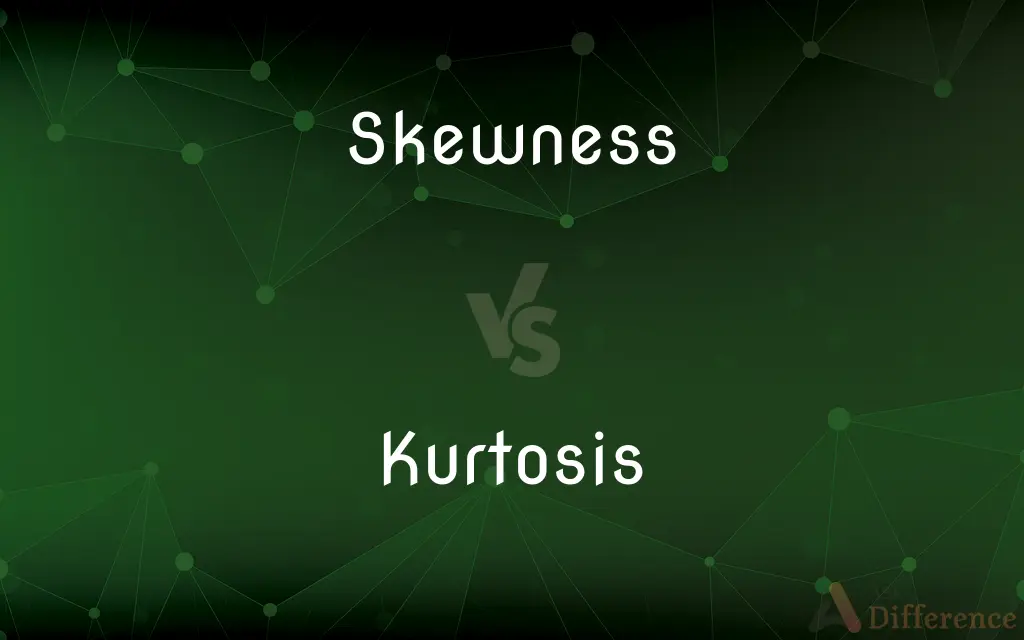Skewness vs. Kurtosis — What's the Difference?
By Tayyaba Rehman — Published on October 25, 2023
Skewness refers to the asymmetry in a frequency distribution, while Kurtosis measures the tail-heaviness of the distribution.

Difference Between Skewness and Kurtosis
Table of Contents
ADVERTISEMENT
Key Differences
In statistical data analysis, Skewness and Kurtosis are pivotal in exploring the structural aspects of the data being observed. Skewness emphasizes the symmetry, or lack thereof, presenting an insightful quantification of the data's deviation from a symmetrical distribution. Kurtosis, conversely, sheds light on the tails and sharpness of a distribution, characterizing the extremity of data distributions.
While Skewness concentrates on the tilt of the data, discerning whether it leans left or right, Kurtosis hones in on identifying the weight of the tails and the peak of data distributions. Skewness, thereby, becomes a reflector of asymmetry, illustrating whether the observations lean towards higher or lower values. Kurtosis amplifies the scrutiny towards outliers, outlining the propensity of the data set to produce extreme values in its tails.
A perfectly symmetrical data set achieves a Skewness of zero, signaling an even distribution of values on both halves of the mean. On the other hand, a normal distribution in terms of Kurtosis relates to a value of three (assuming a standard normal distribution), and deviations from this provide insights into the extremities and peak of the data.
Understanding Skewness allows statisticians and researchers to gauge the likelihood of obtaining values that veer towards one side of the mean, offering implications into potential biases or inclinations in the data. Comprehending Kurtosis, meanwhile, provides a lens into the stability and consistency of the data, revealing the probability of encountering extreme values in the tails of the distribution.
Skewness and Kurtosis, though differing in their focal points, collaboratively furnish a more holistic view of data distributions, enabling a nuanced understanding and thus facilitating more informed, data-driven decision-making. By dissecting asymmetry through Skewness and tail-heaviness through Kurtosis, one is aptly equipped to navigate the realms of data analysis and hypothesis testing with robust statistical grounding.
ADVERTISEMENT
Comparison Chart
Definition
Measures asymmetry of distribution
Measures tail-heaviness of distribution
Nature of Measurement
Captures tilt either left or right
Captures extremity and peak of distributions
Normal Distribution Value
Zero
Three (in standard normal distribution)
Interpretation
Negative/positive indicates left/right skew
High value indicates heavy tails & sharp peak
Application
Identifies data lean towards low/high values
Identifies presence of outliers
Compare with Definitions
Skewness
Positive Skewness indicates a distribution tail on the right.
The asset returns demonstrated positive Skewness, hinting at a rightward distribution.
Kurtosis
Kurtosis provides insight into the probability of outliers.
Through analyzing Kurtosis, it was apparent that outliers were likely.
Skewness
Skewness helps identify biases in data sets.
Analyzing Skewness highlighted a consistent bias towards higher values.
Kurtosis
Kurtosis quantifies the extremity and sharpness of data peaks.
A high Kurtosis revealed the prevalence of sharp peaks in the data.
Skewness
Skewness evaluates the symmetry of data distribution.
The negative Skewness of the data implies a leftward tilt.
Kurtosis
Kurtosis discerns the peakedness in a data distribution.
The low Kurtosis illustrated a less peaked distribution, indicating more uniformity.
Skewness
Skewness of zero implies a perfectly symmetrical distribution.
A Skewness of zero was ideal for ensuring unbiased estimators.
Kurtosis
A Kurtosis of three is indicative of a normal distribution.
The Kurtosis was exactly three, mirroring a normal distribution.
Skewness
High Skewness may signal outliers or extreme values.
The considerable Skewness necessitated a review for potential outliers.
Kurtosis
High Kurtosis implies heavy tails and more outliers.
Financial analysts were concerned by the high Kurtosis and potential risk.
Skewness
To turn or place at an angle
Skew the cutting edge of a plane.
Kurtosis
A quantity indicating how sharply a probability distribution function increases and decreases around the distribution's mean.
Skewness
To give a bias to; distort
The use of a limited sample skewed the findings of the study.
Kurtosis
(statistics) A measure of "heaviness of the tails" of a probability distribution, defined as the fourth cumulant divided by the square of the variance of the probability distribution.
Skewness
To take an oblique course or direction.
Kurtosis
(statistics) Excess kurtosis: the difference between a given distribution's kurtosis and the kurtosis of a normal distribution.
Skewness
To look obliquely or sideways.
Skewness
To display a statistical tendency toward
A television program that skews toward teenagers.
Skewness
Placed or turned to one side; asymmetric.
Skewness
Distorted or biased in meaning or effect.
Skewness
Having a part that diverges, as in gearing.
Skewness
(Mathematics) Neither parallel nor intersecting. Used of straight lines in space.
Skewness
(Statistics) Not symmetrical about the mean. Used of distributions.
Skewness
An oblique or slanting movement, position, or direction.
Skewness
The property of being skew.
Skewness
(statistics) A measure of the asymmetry of the probability distribution of a real-valued random variable; is the third standardized moment, defined as where is the third moment about the mean and is the standard deviation.
Skewness
An oblique or slanting asymmetry
Common Curiosities
What is the normal distribution value for Kurtosis?
A standard normal distribution has a Kurtosis value of three.
How does Kurtosis characterize a distribution?
Kurtosis characterizes the tail heaviness and peakedness of a data distribution.
What does Skewness measure in a distribution?
Skewness quantifies the asymmetry or tilt in a data distribution.
Can both Skewness and Kurtosis be used together?
Yes, Skewness and Kurtosis can jointly offer insights into a distribution’s shape and tail.
How is Kurtosis useful in finance?
In finance, high Kurtosis can indicate risk, reflecting a higher probability of extreme values.
What implies a symmetrical distribution in terms of Skewness?
A Skewness of zero implies a perfectly symmetrical distribution.
Is negative Skewness indicative of leftward asymmetry?
Yes, negative Skewness indicates a leftward tilt in the distribution.
Can Skewness affect statistical inferences?
Yes, Skewness can affect the reliability and validity of statistical inferences.
Is it possible to have high Kurtosis in a symmetric distribution?
Yes, a distribution can be symmetric (Skewness=0) and have high Kurtosis, reflecting sharp peaks.
What represents a right-skewed distribution?
A positive value of Skewness represents a right-skewed distribution.
How is Kurtosis applied in statistical testing?
Kurtosis is utilized to assess the appropriateness of employing parametric statistical procedures.
Does Kurtosis provide insights into outliers?
Yes, high Kurtosis can indicate a higher likelihood of outliers in the distribution.
What indicates platykurtic distribution?
A Kurtosis less than three indicates a platykurtic (less peaked, lighter tails) distribution.
Is Skewness relevant in normal distribution analysis?
Yes, understanding Skewness is essential to analyzing deviations from normal distributions.
What denotes a leptokurtic distribution?
Kurtosis greater than three signifies a leptokurtic (sharply peaked, heavy tails) distribution.
Share Your Discovery

Previous Comparison
Litmus Paper vs. PH Paper
Next Comparison
Cash Credit vs. OverdraftAuthor Spotlight
Written by
Tayyaba RehmanTayyaba Rehman is a distinguished writer, currently serving as a primary contributor to askdifference.com. As a researcher in semantics and etymology, Tayyaba's passion for the complexity of languages and their distinctions has found a perfect home on the platform. Tayyaba delves into the intricacies of language, distinguishing between commonly confused words and phrases, thereby providing clarity for readers worldwide.













































